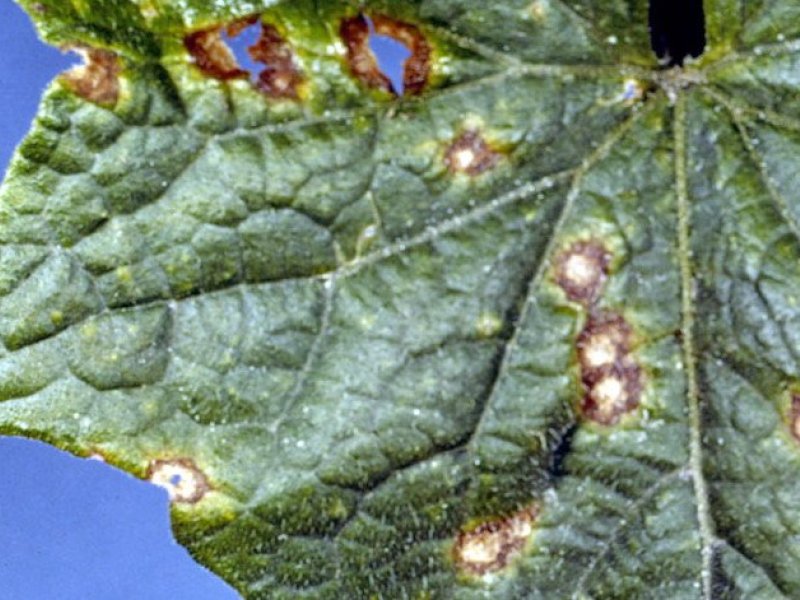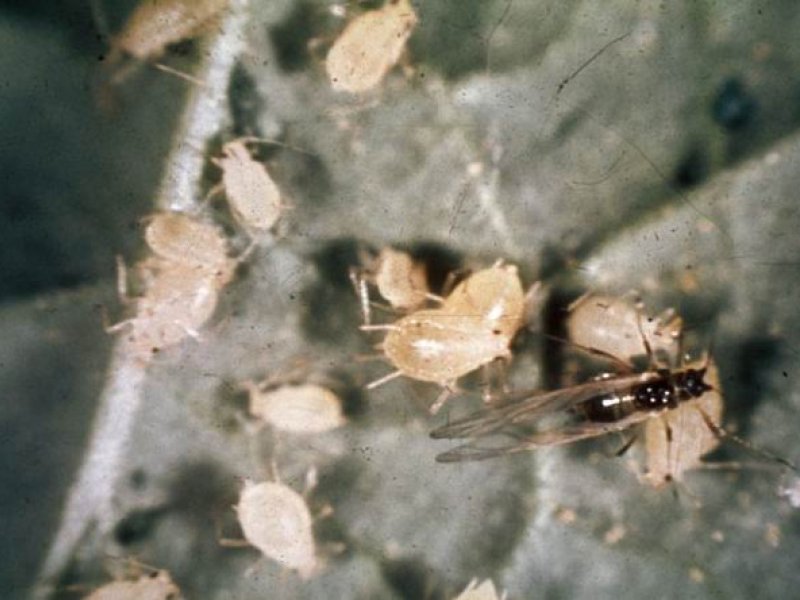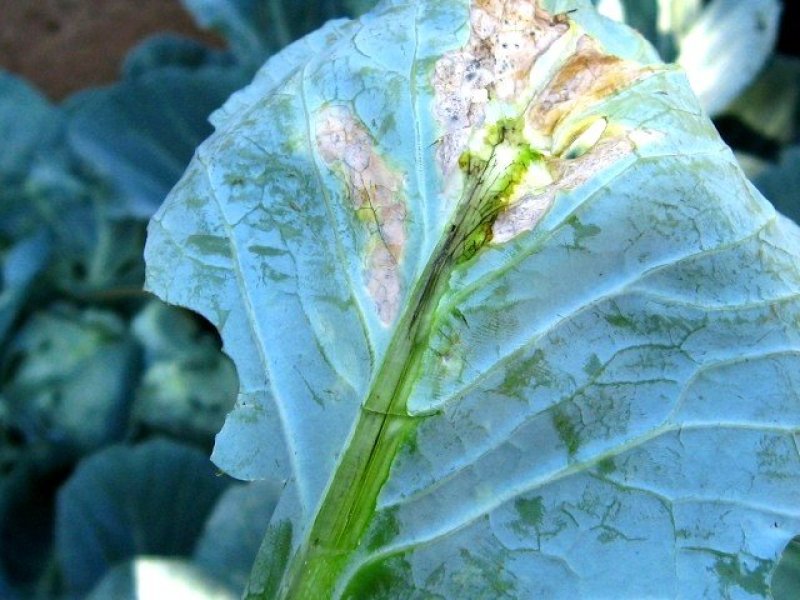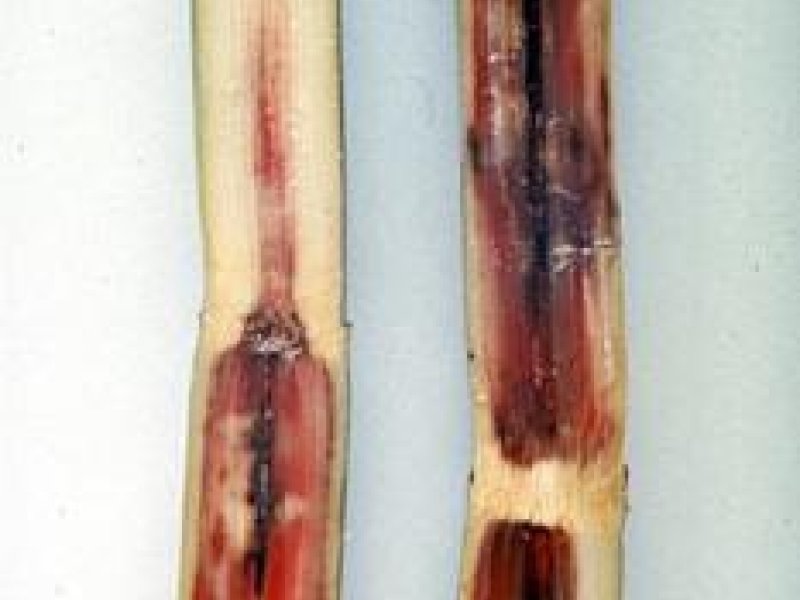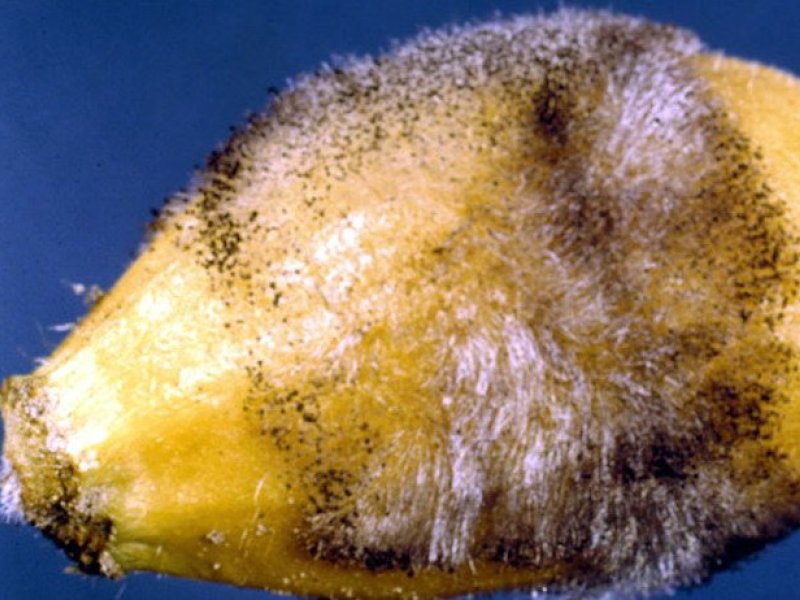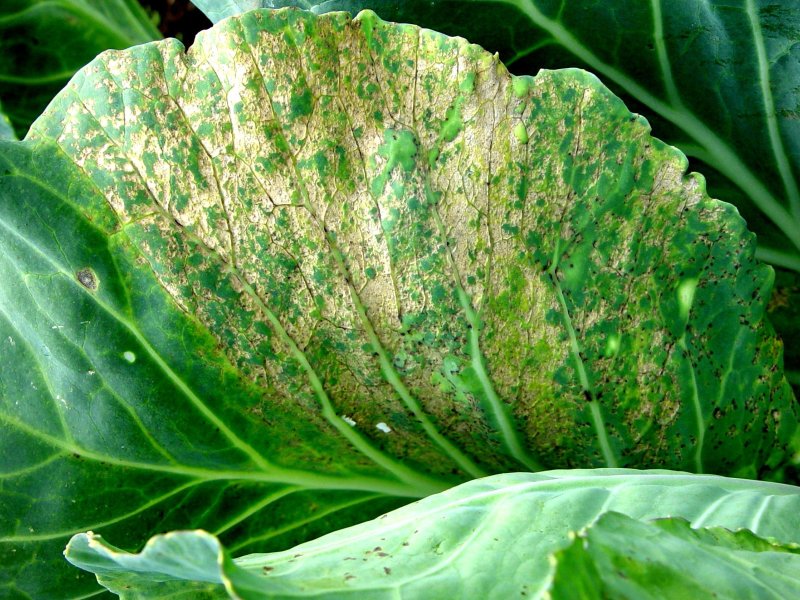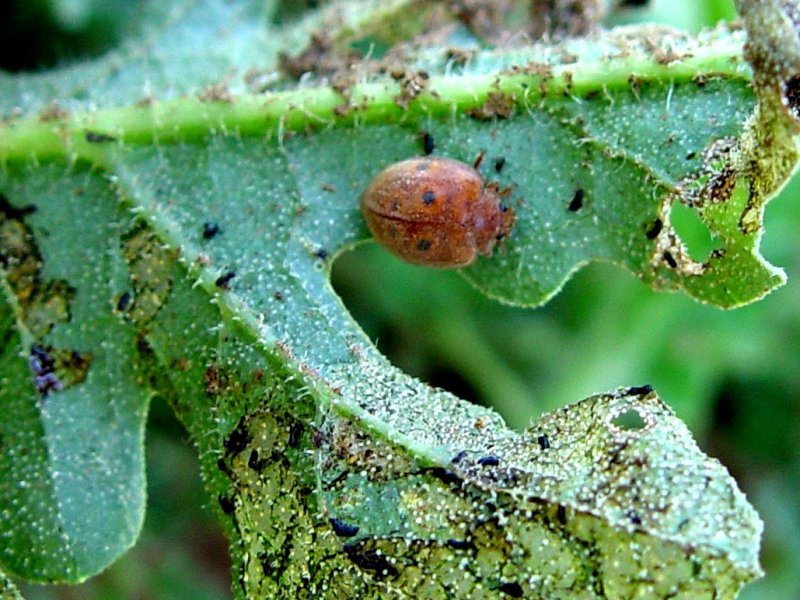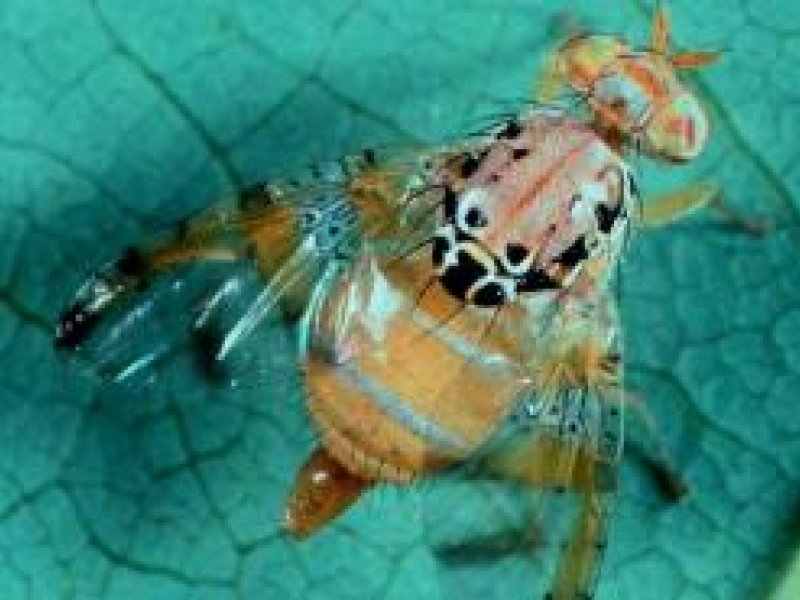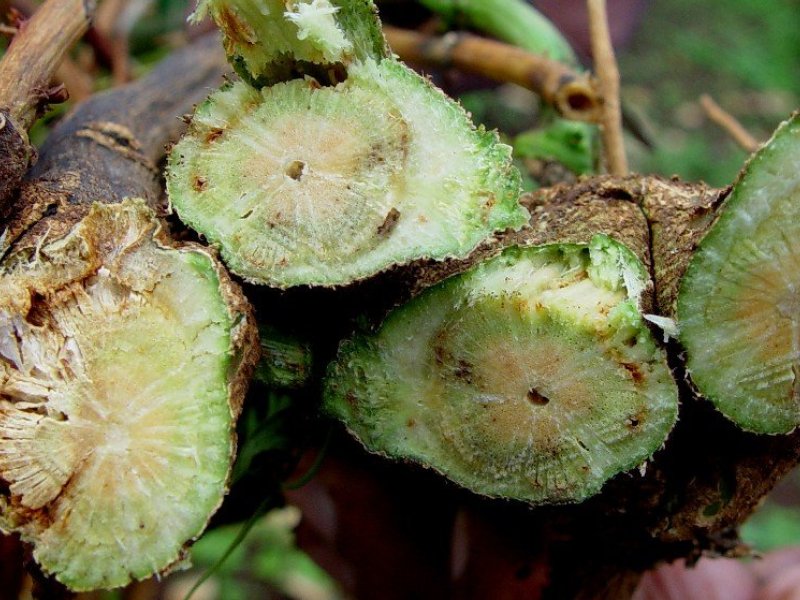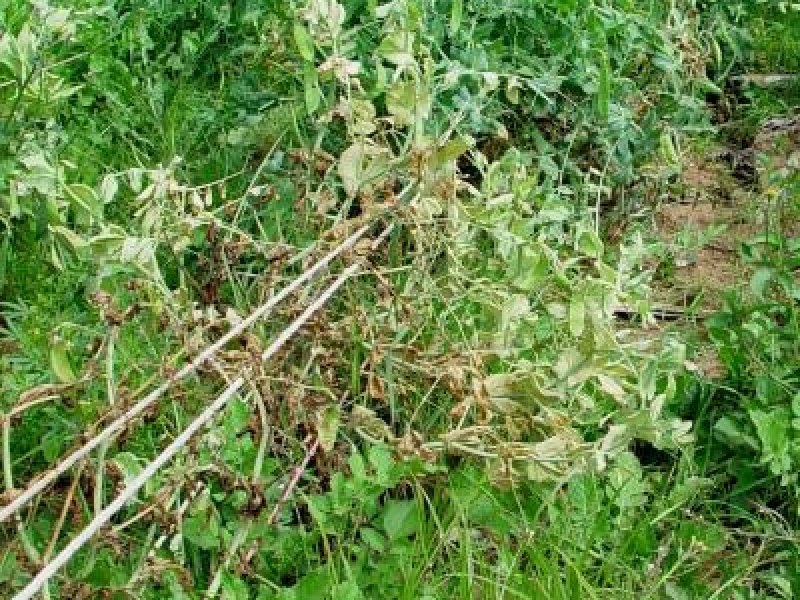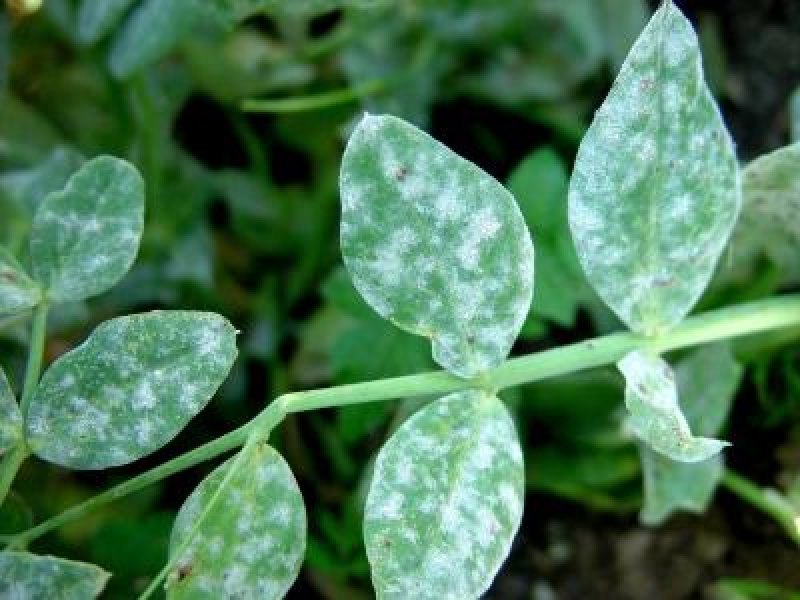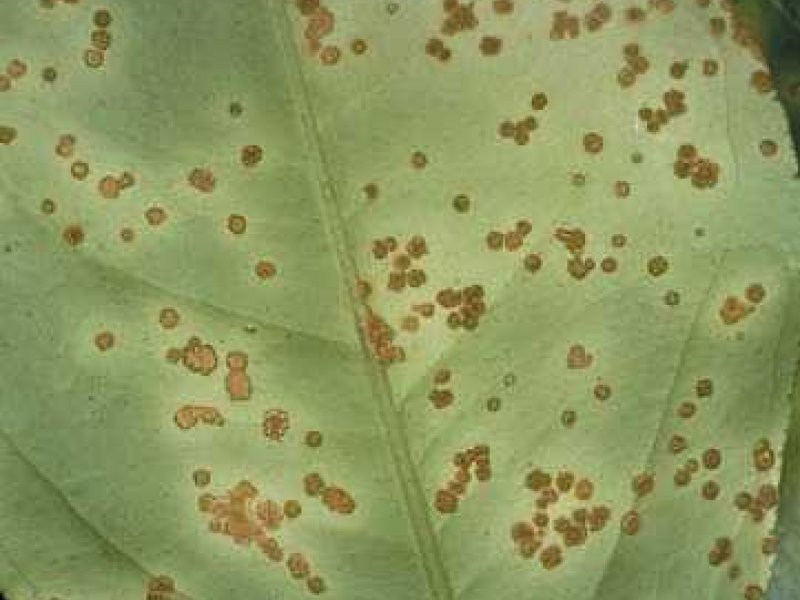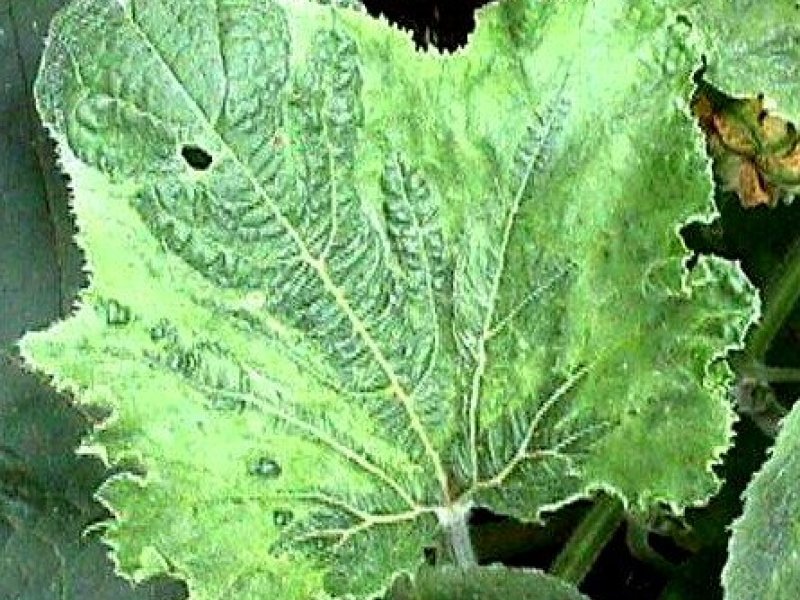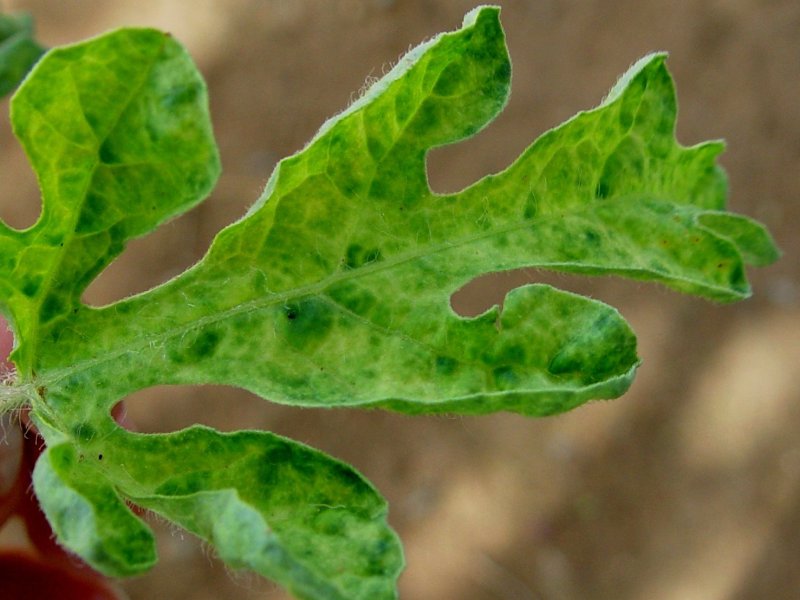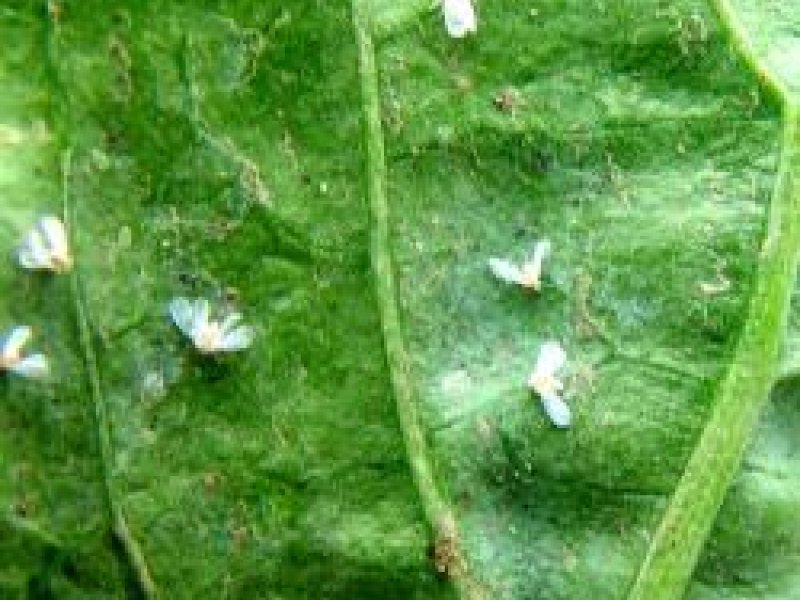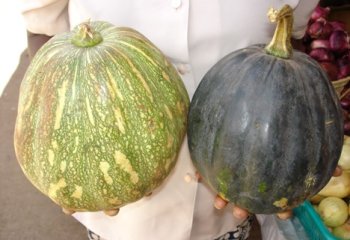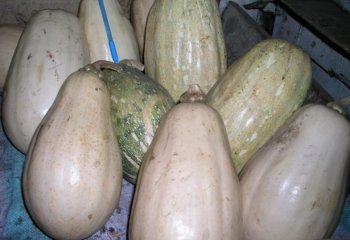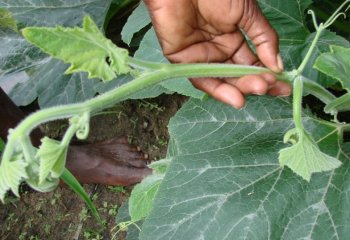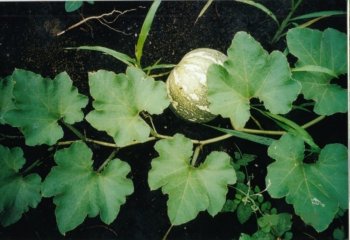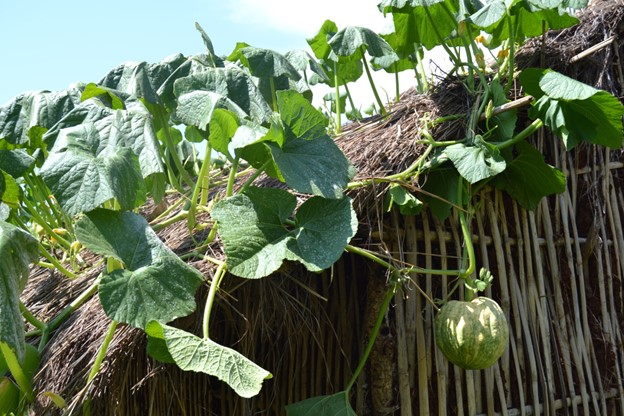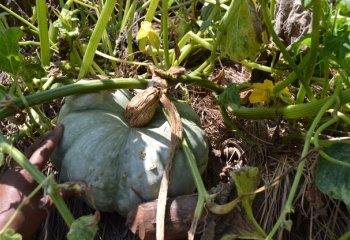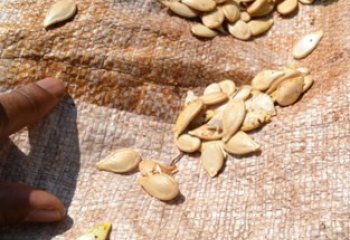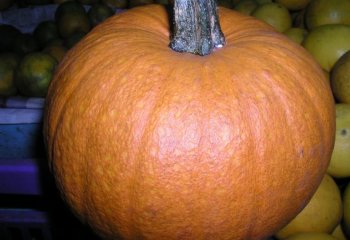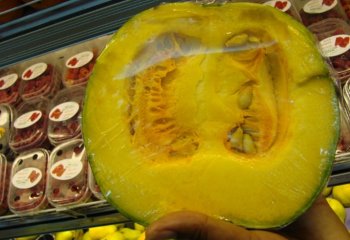|
Anthracnose (Colletotrichum lagenarium (= C. orbiculare)) It is a very destructive disease. It causes defoliation and lesions on the fruits. |
|
|
What to do:
|
|
Aphids (Aphis gossypii) Colonies of green to blackish aphids are found on tender shoots, mainly on the lower leaf surface, where they suck sap. Under heavy attack the growth of attacked shoots is stunted and leaves are curled and twisted. Aphids excrete honeydew, which leads to growth of sooty mould, and may also attract fruit flies. Aphids transmit virus diseases such as the watermelon mosaic virus to pumpkins.
|
|
|
What to do:
|
|
Gummy stem blight and black rot (Didymella bryoniae (= Mycosphaerella citrullina); Phoma cucurbitacearum) Circular to irregular spots on leaves. On centres of the spots pycnidia (fungal fruiting bodies) develop. The spots may tear and drop out giving the leaves a tattered appearance. Crown and runners turn pale-brown and then crack oozing a reddish gum. The affected areas are studded with pycnidia. Runners may be girdled and die. Affected fruits exhibit black, leathery, sunken spots and under moist conditions pycnidia develop at the centres. On butternut squash, large irregular areas of the fruit become bronzed with distinct concentric rings. Fruits are spotted and rot. Infected fruits have no commercial value. |
|
|
What to do:
|
|
Choanephora fruit rot (Choanephora cucurbitarum) C. cucurbitarum mostly attacks tissues that have been damaged by insects or mechanical means. Host tissues have a hairy appearance resulting from the tall fungal filaments that produce a cluster of brown spores (conidia) at their tips. |
|
|
What to do:
|
|
Downy mildew Symptoms on leaves appear as small, pale-yellow areas on upper leaf surface. Under humid conditions, a purplish, grey whitish growth may be seen on the underside of the yellowish spots. Affected leaves curl, shrivel and die. Most downy mildew fungi require cool weather for reproduction and development. This is not true of the cucurbit downy mildew fungus. Optimum temperature for infection is at 16 to 22°C . It can survive when temperatures are over 37.8°C . The most critical factor for infection is a film of moisture and / or long dew periods on leaves. |
|
|
What to do:
|
|
Epilachna beetle (Epilachna chrysomelina) Adults of the Epilachna beetle, also known as the African melon ladybird are 6 to 8 mm long, reddish in colour with a number of black spots on the wing cases. The larvae are 7 to 9 mm in length, soft and covered with dark coloured spines. They pupate on leaves. Both adults and larvae feed on the leaves leaving a fine net of veins. Damaged leaves shrivel and dry up. They may also gnaw stems and eat holes in fruits. These beetles are most likely to be a problem during establishment when plants are small; young plants can be entirely destroyed. Older plants can tolerate considerable leaf damage, but during flowering fruit set maybe affected. This beetle is a vector of squash mosaic virus. The Epilachna beetle attacks all cucurbits. They often fly into a crop from nearby crops.
|
|
|
What to do:
|
|
Fruit flies (Bactrocera cucurbitae, Dacusspp. and Ceratitis capitata) Fruit flies are important pests of cucurbits including pumpkins. Fruit flies pierce the fruits and lay eggs in them. The fruit fly maggots feed inside the fruit causing sunken, discoloured patches, distortions and open cracks. These cracks serve as entry points for fungi and bacteria, which cause fruit rot.
|
|
|
What to do:
|
|
Fusarium wilt (Fusarium oxysporum f.sp. niveum) It causes root rot and corky decay of the stem near ground level, leading to wilting and death. Inside wilted stems the vascular tissue may be discoloured. White to pinkish fungus mycelium may grow over affected tissue. Leaves of affected plants turn yellow and eventually wilt and die. It also causes loss of young plants through damping-off, or of older plants through successive wilting. If fruit has formed, it remains small and loose commercial value. Cucurbits are attacked at all stages of growth. When seedlings are invaded, they may damp-off and die. Older susceptible plants wilt initially, occasionally recover at night, but usually wilt quickly and die. In wet weather, a white or pinkish fungal growth develops on the surface of dead tissues. In advance stages of the disease, roots may decompose. |
|
|
What to do:
|
|
Powdery mildew Symptoms first develop as a whitish talcum-like powdery growth on upper leaf surface. The powdery growth is composed of fungal spore mass. These areas covered by white powdery growth may enlarge and join up to cover both lower and upper leaf surfaces. Severely affected leaves dry, turn brown and become brittle. Vines can be also attacked. Secondary effects of the disease include sun-burning and premature ripening of fruits. |
|
|
What to do:
|
|
Scab (Cladosporium cucumerinum) It attacks all aboveground plant parts. Initial symptoms on leaves appear as light water-soaked or pale green spots. The spots are numerous and can appear on and between veins. Elongate spots may develop on petioles and stems. The spots later turn grey to white and become angular. The fine veinlets in the spots may be brown and are distinct against a white background. Dead leaf tissue cracks and breaks away until the whole leaf is ragged. Fruits can be attacked at all stages of growth. However, young fruits are most susceptible. Plant tissue near the spots may produce sap, initially watery but later becomes gummy to hard. The fruit spots are cankerous and with time become darker, sunken until a pronounced cavity is formed. Under moist weather, a dark-green velvety layer of fungal growth appears on the cavities. The fungus survives in crop debris, soil and on seed. It is spread by insects, farm tools and wind. The disease is most severe at 100% relative humidity and at relatively cool temperatures (21-25°C ). Its host range includes cantaloupe, gherkin, muskmelon, pumpkin, squash and watermelon. |
|
|
What to do:
|
|
Virus diseases Many important virus diseases affect cucurbits. These include: Cucumber mosaic cucumovirus (CMV) Watermelon mosaic 2 potyvirus (WMV-2) Watermelon mosaic 1 potyvirus Zucchini yellow mosaic potyvirus (ZYMV) Squash leaf curl bigeminivirus (SLCV) Cucumber mosaic virus It is not seed transmitted except through seed of perennial wild cucumber (Echinocytis lobata) and chickweed (Stellaria media). It is mechanically transmitted and in nature it is spread by various species of aphids. It has a very extensive host range including such varied species as bananas, carrots, cowpeas, lupine, lilies, onions, passion fruit, potatoes and tomatoes. Watermelon mosaic virus This virus is mechanically transmitted and also spread by several species of aphids. It is not seed transmitted. Its host range is primarily restricted to cucurbits although one of its strains infects peas. Squash mosaic virus It is mechanically transmitted. It is transmitted through seeds of melons and squash. It is also transmitted by spotted, striped and banded cucumber beetles, which attack cucumbers in the Americas. The Epilachna beetle (Epilachna chrysomelina) a pest of cucumber in Africa, is also vector of squash mosaic virus. Its host range includes cucurbits, peas, coriander, and salad chervil.
|
|
|
What to do:
|
|
Whiteflies (Bemisia tabaci) Whiteflies suck plant sap and excrete honeydew where moulds growth and may affect plant growth. However, the major damage is caused as vectors of various virus diseases, which cause considerable damage to cucurbits. |
|
|
What to do:
|
Geographical Distribution in Africa
Geographical distribution of Pumpkin in Africa. Updated on 5 July 2019. Source FAOSTAT
GBIF secretariat, 2021rcub © OpenStreetMap contributors, © OpenMapTiles, GBIF. https://www.gbif.org/species/2874506
Evidence shows that people have cultivated Cucurbita species since about 8000 BC, with no wild forms found. C. pepo mainly spread northward to the United States, while C. moschata and C. mixta spread both northward (United States) and southward (Central and northern South America). C. maxima remained confined to South America. After the New World discovery, Cucurbita species were introduced to the Old World, leading to diverse centers in Asia and Africa. Limited data is available about the four species' importance in Southeast Asia, but C. moschata appears to be the most prevalent due to its suitability for lowland tropics (PROSEA, 2016). https://powo.science.kew.org/taxon/urn:lsid:ipni.org:names:13252-1
Read more
Local Names (Detailed):
Benin: Éléguédé (Tchabè); Gnianrou (Bariba); Leptanda (Dendi); Lifèli (Gourmantché); Tipeti (Otammari) (Curcubita maxima); Aguidi, Ewe Eleguede (Holly); Aguidigbèdjè (Idatcha); Dipeeri, Tipétipésiiti (Otammari); Gboo (Tchabè); Kanhin, Kansin (Boko); Kufelugu, Tifefari (Gourmantché); Ninnibu (Waama); Wianru (Bariba);(C. pepo & C. moschata). (Achigan et al., 2010).
Burkina Faso: Yow-var, Yovar, Yovaar (Dagara) (C. pepo); Yo, Yow (Dagara); (C maxima) (Maundu, 2015).
DRC: Mbika; Malenge (Kongo), Courge (Fr.) (C. maxima); (Latham, P., & Mbuta., 2014)
Ethiopia Adubi (O), Duba, Hamham (C. maxima); Bahir-k’il, Yek’wara-areg, Dabak’ula, Wushish, Hamham, Bakula (C. Pepo) (FAO, 1988).
Kenya: Budho (Luo); Malenge (Kiswahili); Lisebebe (Luhya); Marenge (Kikuyu); Risoa (Kisii); Ulenge (Kamba) (Maundu et al., 1999); Kahurura (Kikuyu) (C. ficifolia) (Grubben, G.J.H., 2004); Boga (Swahili) (FAO, 1988).
Malawi: Dzungu, Nkhwani (Chewa), Iyongu (Yao), Msuku (Lomwe), Tange (Tonga), Jungu (Tumbuka), Mungu (Ngoni) (C. maxima); Muangasira (Chewa), Matanga, Matandu (C. Pepo) (FAO, 1988).
Mozambique: Mutikiti (C. maxima, C.moschata) (Maundu, 2006).
Sudan: Araa/garaa-stambuli ur assail (C. maxima); Kossa (Arabic) (C. Pepo) (FAO, 1988).
Tanzania: Masuti (Majani ya maboga) (C.maxima,); (Chacha J & Laswai S.H., 2020); Boga, Miboga (Swahili) (FAO, 1988)
Uganda: Ensujja (Lugbara), Enssunsa (Lugbara), Buziriziri, Kimisebebe, Mawondo, Kasogo, Nyaryeng’a, Amugita, Imunyuru, Asusa, Okondo, Kedi, Inju, Enjub, Nyomboli, Kicwica, Okono, ebishusha, Obututu, Ebyoozi (Fruit) (C. maxima) (FAO, 1988).
Zambia: Kapanda, Litanga, Kajunga, Katanga,Maungu, Vipizi, Zungu, Chipushi (C. maxima); Chibwabwa, Mkwani (Leaves) (C. pepo) (FAO, 1988).
Zimbabwe: Mubovard, Mumhodzi (Leaves), Munhanga (Pumpkin) (FAO, 1988).
General Information and Agronomic Aspects
Introduction
Pumpkin refers to certain varieties of Cucurbita moschata, C. maxima, and C. argyrosperma. The native range of these species are: C. moschata – Mexico south to Guatemala (middle Central America); Cucurbita maxima: North Argentina, Peru and Bolivia; C. argyrosperma: Mexico to Nicaragua. These and other related cucurbits provide pumpkins and butternuts (Cucurbita moschata), squashes (C. maxima), gourds (C. argyrosperma), and zucchini or courgettes and ornamental gourds (C. pepo). Distinguishing them is often difficult. Pumpkins have long-running, bristled stems, large deeply-lobed leaves often containing white blotches and yellow or orange flowers separated into male and female types on the same plant. The fruit is variable in shape and colour but is often white, cream or green, containing about 70% flesh and several large white seeds.
Fruits, leaves and flowers of these cucurbits are used as vegetables, and their seeds are consumed roasted as a snack food. Pumpkin fruit contains 1% protein and 8% carbohydrates, and the dried seeds contain 23% protein, 21% carbohydrates and up to 50% oil, but little information is available about the nutritional characteristics of cooked leaves.
Ⓒ Adeka et al., 2005
There are numerous types and cultivars, which differ greatly in composition and therefore in their suitability for certain culinary uses. The younger leaves are collected and the outer tough skin of petioles (stalk of leaf) removed (together with the large leaf veins) then washed, chopped and boiled.
Immature and mature fruits of C. moschata are used as a blanched, steamed or fried vegetable and as an ingredient of soups. Various desserts are made from the fruits: steamed flesh with grated coconut and sugar, crisps made from steamed mashed flesh mixed with cassava flour, pumpkin custard, pumpkin pudding, pumpkin in coconut milk and sweet pumpkin paste. Ornamental gourds are cultivars of C. pepo with small, bitter and inedible fruits in many shapes, sizes and colors. The potential of the seeds as a source of vegetable fat and protein has not been fully exploited. Fresh seeds have been reported to be used as a vermifuge, and seed decoctions as diuretic and to reduce fevers.
The pumpkin has been much used as a medicine in Central and North America. It is a gentle and safe remedy for a number of complaints. The seeds are widely used as an anthelmintic. The complete seed, together with the husk, is used to remove tapeworms. They are especially useful effective as tapeworm treatment for children and pregnant women for whom stronger and toxic remedies are unsuitable. The seeds are ground into fine flour, then made into an emulsion with water and eaten. It is then necessary to take a purgative afterwards in order to expel the tapeworms or other parasites from the body. The fruit and seed decoctions have been reported to be used as diuretic and to reduce fevers, and are used for curing indigestion. The pulp is applied to burns and scalds, inflammation, abscesses and boils. It is also used in the treatment of migraine and neuralgia.
(Plants for a Future 2003; CAB 2006, Woomer and Imbumi, 2005).
Species accounts
Cucurbita moschata is an annual climbing plant with stems growing to a length of up to 5 metres. These stems tend to sprawl over the ground, though they also climb into the surrounding vegetation where they support themselves by means of tendrils. Leaves: large, lobed, and covered with soft hairs, sometimes with white markings often disappearing as the leaves age. Flowers: solitary, unisexual, lemon yellow to deep orange; sepals free. Fruits: may be of varying shapes and colour - globose to ovoid to cylindrical and may weigh up to 10 kg. It may be green to dark green often covered with grey-white stripes, changing to light green or cream with age. Flesh: yellow to orange, many-seeded; fruit stalk enlarged at apex. Seed: flattened, usually white. The fruit is ideal for roasting and in soups.
Ⓒ Maundu, 2001
Cucurbita moschata is the most heat tolerant Cucurbita species and the most widely cultivated in tropical Africa. It is most probably cultivated in all countries of tropical Africa.
Cucurbita moschata includes important cultivars like pumpkins and butternut squash. C. moschata is commonly used as a leafy vegetable, where the young leaves and shoots are cooked and eaten as a green vegetable. Its fruit can be cooked in a variety of ways, including baking, roasting, and steaming. Its flesh can be used in soups, stews, casseroles and in pies and desserts.
(Grubben & Ngwerume, 2004, Tropical Plants Database (n.d), missouribotanicalgarden.org).
C. moschata varieties
Varieties of butternut available in Kenya
• "Butternut 401". It has resistance to powdery mildew
• "Bugle". It has resistance to powdery mildew.
• "Early Butternut F1". It has resistance to powdery mildew.
• "Ultra F1". It has resistance to Fusarium wilt and powdery mildew.
• "Waltham". It has resistance to powdery mildew.
Seeds of the above listed varieties are available at the major seed companies in Nairobi (e.g. East African Seed Company Ltd., Amiran Kenya Ltd. and Simlaw Seeds Co. Ltd)
Curcubita maxima is an annual vine climbing by lateral, 2–5-branched tendrils, strongly branched. It is a fast-growing plant that can reach up to 10 meters in length. Stems: rounded stems that are long running and softly pubescent. Leaves: alternate ad simple lobed leaves that are rough to the touch. Flowers: yellow flowers of the plant are quite large and showy. Fruit: large, globose to ovoid or obovoid berry that weighs up to 50 kg with a wide range of colors (orange, green etc.), has a thick, hard rind enclosing the pulp and seeds. Seeds: flattened, white to pale brown, surface smooth to somewhat rough, margin prominent. Many cultivars of C. maxima that exhibit various morphological and physiological characteristics exist across in Europe and Africa. The plant prefers warm temperatures and well-drained soil and is often grown in gardens and small farms.
C. maxima is used as a food source, the mature fruits, leaves, flowers and seeds are used as vegetables. In addition to being grown for its fruit, the species is also grown for its leaves, which are highly nutritious and have a variety of culinary uses. The leaves are regarded as a bit coarse and of lesser quality than those of Cucurbita moschata, although this disappears in cooking. They are used fresh and in some locations dried for use during the off-season. Curcubita maxima is native to South America, perhaps the area around N. Argentina, Chile and Bolivia. It has been introduced into most tropical and sub-tropical countries of the world. In Cameroon, Nigeria and other western African countries, seeds are commonly roasted and salted, or ground into a thick paste that is mixed with vegetables in cooking.
(Chigumira Ngwerume, F. & Grubben, G.J.H., 2004).
©Maundu 2015
©Maundu, 2015
©Maundu 2015
Ⓒ Foods of Nairobi people, 2001
Cucurbita pepo is an annual, scandent herb, climbing by lateral, 3–4-branched tendrils, strongly branched, or with bushy habit and then often without tendrils; Stems: angular and often grooved, prickly hairy. Leaves: alternate, simple, without stipules. Flowers are yellow to orange and unisexual. Fruit: are large, globose to ovoid, obovoid, cushion-shaped or cylindrical berry, weighing up to 50 kg when mature, with a wide range of colours, with small, raised, wartlike spots or smooth, sometimes deeply grooved. Flesh: soft, whitish to yellow or orange, many-seeded. Seeds: obvoid, flattened, usually white
Principal features distinguishing Cucurbita pepo from other cultivated Cucurbita species are more deeply lobed leaves with silvery markings, prickly hairy stems and leaves and fruit stalk hard and pentagonal in cross-section. Cucurbita pepo tolerates monthly average day temperatures of 18–28°C, but growth is best when day temperatures are between 24°C and 29°C and night temperatures between 16°C and 24°C, as found at high altitudes in East Africa or at higher latitudes. Production is mostly restricted to the beginning of the dry season, when temperatures are relatively low and the pressure of aphids less intense. C. pepo is less adapted to tropical lowlands than C. moschata, especially during the rainy season. The young leaves and shoots are used as a potherb e.g. in south-western Nigeria, but in general the leaves of Cucurbita moschata are preferred, being less coarse. C. pepo included important vegetables such as Zucchini (courgettes), pumpkins, acorn squash, yellow squash, pattypan squash (scallop squash), etc.
Male flowers of courgette are sometimes used to make fritters. ‘Vegetable spaghetti’ cultivars are a speciality; when cooked the flesh of mature fruits resolves into thin strands which look like spaghetti. Cucurbita pepo seeds are edible in the same way as those of other cucurbits, either raw or roasted. Cucurbita pepo is less heat resistant than Cucurbita moschata and for that reason less appropriate for tropical Africa, yet it is grown on a limited scale in all countries (Messiaen & Fagbayide, 2004).
Ecological conditions
Pumpkins and squashes (various Cucurbita spp.) are grown in the tropics from the lowlands up to 2500 m altitude. They are warm-season crops adapted to monthly mean temperatures of 18-27°C. C. maxima is the most tolerant of low temperatures, C. moschata and C. argyrosperma the least, with C. pepo intermediate. C. maxima and C. pepo have long been cultivated in temperate regions. Butternut appreciates part shade in very hot conditions, such as can be obtained when intercropped with other crops or grown under fruit trees.
Pumpkins and squashes respond very well to medium to heavy applications of compost or well- decomposed manure. They can be cultivated on almost any fertile, well-drained soil with a neutral or slightly acid reaction (pH 5.5 to 7). They are drought-tolerant, requiring relatively little water, and are sensitive to waterlogging. Excessive humidity is harmful because of the development of leaf diseases, so none of the species do well in the humid tropics.
Agronomic aspects
Pumpkins and squashes are grown from seed. Seeds may be sown in containers and transplanted to the field when they are 10 cm high. Direct seeding of 2 to 3 seeds per hill is commonly practised. Trailing types are planted at distances of 2-3 m either way; the seed requirement is 2 to 3 kg/ha. The bushy types (mainly C. pepo) are planted closer, for example, plants spaced 60 to 120 cm in rows 1 to 1.5 m apart; the seed requirement is 3 kg/ha for pumpkin and 7 kg/ha for summer squash (C. pepo). Do not use seeds from plants where edible pumpkins and ornamental gourds are grown close together. Offspring will be bitter or even inedible.
Husbandry
Sole cropping is sometimes used for commercial production. Pumpkins and squashes are also planted in home gardens or mixed with field crops such as maize. Cultural practices to improve growth and development include the removal of growing tips (in trailing varieties) to check growth, and the bagging of fruits in paper to protect against fruit fly and other pests. Fruit setting may be stimulated by manual pollination. The fruit may rot when in contact with moist soil, so often cut grass or leaves are placed beneath the fruit.
Harvest, post-harvest practices and markets
Harvest
Winter squashes and pumpkins are picked when mature in a once-over harvest or in several rounds, about 90 to 120 days after planting depending on variety. When grown as leaf vegetable, usually the third and fourth leaves are harvested, while the tip and second leaves are left to grow. Young leaves and shoots are picked when needed. Pumpkins are considered to be among the most efficient of vegetable crops when evaluated on nutritional yield in relation to land area and labour needed. Indicative figures for seed yield of C. pepo are 400 to 1500 kg/ha. A valuable source of oil and protein is thus neglected if the seeds are left unutilised. In seed production, isolation between fields of different Cucurbita species is recommended, not only for reason of purity but also for obtaining maximum yields (pollen of other species may cause reduced fruit set).
Post-harvest practices
After harvesting pumpkins should be handled carefully to avoid bruising or damaging the skin. Use soft padding or cloth when transporting them to prevent scratches. Gently wipe off any dirt or debris using a soft cloth or brush. Avoid using water, as excess moisture can lead to decay. Mature pumpkin fruits can be cured in the sun, or under controlled conditions of 27-29 °C and 80-85% relative humidity for 10 days. This helps toughen the skin, extend shelf life, and enhance flavor.
Store pumpkins in a cool, dry, and well-ventilated area. The ideal temperature is around 10-13°C. Avoid direct sunlight, as it can cause them to deteriorate quickly. Ensure that pumpkins are not touching each other during storage to prevent potential rot from spreading. If harvested and stored properly, pumpkins can last for up to 3 months and in some cases 7 months. The pumpkin flesh can be dried in strips and reserved for soups and stews. While eating the fruits, people usually remove seeds; some are kept for planting later, and others are used as food.
(PROSEA, 2016, Chigumira Ngwerume, F. & Grubben, G.J.H., 2004)
Markets
Pumpkins have a vast market, both locally and internationally. Qualities sought after in the markets include: Size and color consistency, along with a healthy appearance, Blemish-free skins, vibrant colors, and uniformity in shape contribute to a pumpkin's marketability. Moreover, taste, texture, and overall freshness play a crucial role in consumer preferences.
The countries with the highest volumes of production in 2021 were China, India and Ukraine, with a combined 50% share of global production.
Countries with the highest volumes of consumption in 2021 were China, India and the United States, together comprising 51% of global consumption. Ukraine, Russia, Bangladesh, Italy, Turkey, Indonesia and Algeria lagged somewhat behind, together accounting for a further 19
Pumpkins are grown for processing and fresh for ornamental sales. Local farmers' markets, grocery stores, and supermarkets are common retail outlets. Online marketplaces have also gained popularity, offering convenience to consumers seeking fresh produce. Additionally, food processing companies purchase pumpkins for canned products like purees and soups.
Further reading: https://www.indexbox.io/store/world-pumpkin-squash-and-gourds-market-report-analysis-and-forecast-to-2020/
Fresh Quality Specifications for the Market in Kenya
 |
| © S. Kahumbu, Kenya |
Nutritional value and recipes
Pumpkin is a healthy, versatile vegetable loaded with a variety of nutrients, including fiber, vitamins, minerals, and antioxidants. The fruits are low in calories but rich in vitamins and minerals, which are found in its seeds, leaves, and Flesh.
Pumpkins are a good source of dietary fiber, supporting digestive health by promoting regular bowel movements and preventing constipation. Pumpkins contain potassium, which is important for maintaining fluid balance, muscle function, and blood pressure regulation. They also provide smaller amounts of other minerals like calcium, magnesium, and iron.
Pumpkins are a good source of vitamins A and C. Vitamin A is essential for maintaining good vision, a healthy immune system, and skin health. Vitamin C is an antioxidant that supports the immune system and skin health as well.
Pumpkins are loaded with antioxidants like beta-carotene, which gives them their vibrant orange color. Beta-carotene is converted into vitamin A in the body and is known for its potential to protect cells from oxidative stress and reduce the risk of chronic diseases. The high levels of beta-carotene in pumpkins are beneficial for maintaining good vision. Beta-carotene is a precursor to vitamin A, which is essential for the health of the retina and overall eye health.
(Healthline (n.d), WebMD (n.d)
Table 1: Proximate nutritional value 100g edible portion
|
Pumpkin, flesh, yellow w/o seeds, raw |
Pumpkin, flesh, yellow w/o seeds, boiled, drained (without salt) |
Pumpkin, flesh, yellow w/o seeds, boiled, drained (without salt) |
Recommended daily allowance (approx.) for adults a |
Edible conversion factor |
0.8 |
1 |
|
|
Energy (kJ) |
134 |
146 |
119 |
9623 |
Energy (kcal) |
32 |
35 |
28 |
2300 |
Water (g) |
90.3 |
89.5 |
91.4 |
2000-3000c |
Protein (g) |
1.2 |
1.3 |
1.1 |
50 |
Fat (g) |
[0.2] |
0.2 |
0.2 |
<30 (male), <20 (female)b |
Carbohydrate available (g) |
5.2 |
5.6 |
4.6 |
225 -325g |
Fibre (g) |
2.4 |
2.6 |
2.1 |
30d |
Ash (g) |
0.7 |
0.8 |
0.7 |
|
Minerals |
|
|
|
|
Ca (mg) |
17 |
18 |
15 |
800 |
Fe (mg) |
0.2 |
0.2 |
0.2 |
14 |
Mg (mg) |
12 |
8 |
11 |
300 |
P (mg) |
31 |
30 |
27 |
800 |
K (mg) |
178 |
97 |
157 |
4,700f |
Na (mg) |
14 |
11 |
12 |
<2300e |
Zn (mg) |
0.21 |
0.17 |
0.19 |
15 |
Se (mcg) |
1 |
0 |
0 |
30 |
Bioactive compounds |
|
|
|
|
Vit A RAE (mcg) |
126 |
123 |
100 |
800 |
Vit A RE (mcg) |
252 |
246 |
201 |
800 |
Retinol (mcg) |
0 |
0 |
0 |
1000 |
b-carotene equivalent (mcg) |
1512 |
1479 |
1204 |
600 – 1500g |
Thiamin (mg) |
0.07 |
0.05 |
0.06 |
1.4 |
Riboflavin (mg) |
0.06 |
0.04 |
0.05 |
1.6 |
Niacin (mg) |
0.78 |
0.5 |
0.7 |
18 |
Dietary Folate Eq. (mcg) |
50 |
27 |
31 |
400f |
Food folate (mcg) |
50 |
27 |
31 |
400f |
Vit B12 (mcg) |
0 |
0 |
0 |
3 |
Vit C (mg) |
8 |
6 |
6 |
60 |
Source (Nutrient data): FAO/Government of Kenya. 2018. Kenya Food Composition Tables. Nairobi, 254 pp. http://www.fao.org/3/I9120EN/i9120en.pdf
RE=retinol equivalents.
RAE =Retinol activity equivalents. A RAE is defined as 1μg all-trans-retinol, 12μg beta-carotene, or 24μg α-carotene or β-cryptoxanthin.
*The specific Pumpkin species is unknown.
a Lewis, J. 2019. Codex nutrient reference values. Rome. FAO and WHO
b NHS (refers to saturated fat)
c https://www.hsph.harvard.edu/nutritionsource/water/
d British Heart Foundation
e FDA
f NIH
g Mayo Clinic
Nutritive Value per 100 g of edible Portion
| Raw or Cooked Pumpkin |
Food Energy (Calories / %Daily Value*) |
Carbohydrates (g / %DV) | Fa t(g / %DV) | Protein (g / %DV) | Calcium (g / %DV) | Phosphorus (mg / %DV) | Iron (mg / %DV) | Potassium (mg / %DV) | Vitamin A (I.U) | Vitamin C (I.U) | Vitamin B 6 (I.U) | Vitamin B 12 (I.U) | Thiamine (mg / %DV) | Riboflavin (mg / %DV) | Ash (g / %DV) |
| Pumpkin cooked | 20.0 / 1% | 4.9 / 2% | 0.1 / 0% | 0.7 / 1% | 15.0 / 1% | 30.0 / 3% | 0.6 / 3% | 230.0 / 7% | 4992 IU / 100% | 4.7 / 8% | 0.0 / 2% | 0.0 / 0% | 0.0 / 2% | 0.1 / 5% | 0.6 |
| Pumpkin raw | 26.0 / 1% | 6.5 / 2% | 0.1 / 0% | 1.0 / 2% | 21.0 / 2% | 44.0 / 4% | 0.8 / 4% | 340 / 10% | 7385 IU / 148% | 9.0 / 15% | 0.1 / 3% | 0.0 / 0% | 0.1 / 3% | 0.1 / 6% | 0.8 |
*Percent Daily Values (DV) are based on a 2000 calorie diet. Your daily values may be higher or lower, depending on your calorie needs.
Recipes
1. Malenge (pumpkin fruit)
(Kamba, Kitui, Kenya)
Ingredients
1 Pumpkin fruit
Salt to taste
Method
Wash the pumpkin fruit well
Split into pieces you want
Remove seeds
Put in a pot or sufuria containing water and salt to taste
Take pumpkin leaves, wash and use for covering the pot
Cook for 10 minutes
Serve with tea
Source: Maundu et al., 2004
2. Pumpkin seeds
(Kamba, Kitui, Kenya)
Ingredients
Pumpkin seeds
Salt to taste
Method
Wash the seeds well to remove dirt
Dry them in the sun
Season them with salt
Roast on a pan under low heat
Serve warm as a snack
Source: Maundu et al., 2004
3. Chapati malenge
(Kamba, Kitui, Kenya)
Ingredients
1 Pumpkin
Salt
Wheat flour
Remove pumpkin skin
Cut into pieces
Boil till well cooked
Salt to taste
Mash the pumpkin
Add 1 cup of hot water
Add some oil
Mix with wheat flour and knead well to make dough
Roll out the dough
Shallow fry the chapatti in oil
Source: Maundu et al., 2004
4. Mukimwa wa isyo
Ingredients
1 Kg green pigeon peas
1 Pumpkin fruit (small size)
5 large sized potatoes
5 Pumpkin leaves
Onions
1Kg green maize
3 tablespoon ghee
Method
Prepare 1Kg green pigeon peas
Boil green maize and green pigeon peas together till well cooked
Add peeled Irish potatoes, cook for 10 minutes
Cut pumpkin fruit into pieces and add to the cooked githeri
Cook for 10 minutes
Add pumpkin leaves, onions, stir well
Add salt to taste
Add ghee or margarine let it melt
Pound the mixture
Serve warm
Source: Maundu et al., 2004
5. Nomdlomboyi
Ingredients
3 mugs amaranth leaves
5 litres water
2 young pumpkins, size of butternut, diced
3 mugs coarsely ground maize flour
• Preparation
• Wash the pot
• Wash the leaves
• Wash and cut the pumpkins
• Add the water, leaves, and pumpkin to the pot
• Place the 3 legged pot on a stand over the wood fire
• Using a stick, mix the leaves with two young pumpkins
• Add 2 liters of water and increase the heat of the fire
• Boil the mixture
• Add the ground maize flour, cover, and cook for 30 min
• Mix for 10 minutes
• Cover the pot and reduce the heat of the fire
• Cook for 60 minutes
Variation
Allow the pumpkin fruit to cook for a while then add Amaranth leaves and let it cook and the food is ready to eat
Source: Maundu et al., 2004
Information on Pests
Pumpkin and butternut are affected by similar pests as other cucurbits; since they belong to the family Cucurbitacea, including melons, squash, zucchini (courgettes) and cucumber.
For more information on pests attacking cucurbits refer also to page on cucumber click here
Examples of Pumpkin Pests and Organic Control Methods
| Colonies of green to blackish aphids are found on tender shoots, mainly on the lower leaf surface, where they suck sap. Under heavy attack the growth of attacked shoots is stunted and leaves are curled and twisted. Aphids excrete honeydew, which leads to growth of sooty mould, and may also attract fruit flies. Aphids transmit virus diseases such as the watermelon mosaic virus to pumpkins.
What to do:
|
| Whiteflies suck plant sap and excrete honeydew where moulds growth and may affect plant growth. However, the major damage is caused as vectors of various virus diseases, which cause considerable damage to cucurbits. What to do:
|
| Epilachna beetle (Epilachna chrysomelina) Adults of the Epilachna beetle, also known as the African melon ladybird are 6 to 8 mm long, reddish in colour with a number of black spots on the wing cases. The larvae are 7 to 9 mm in length, soft and covered with dark coloured spines. They pupate on leaves. Both adults and larvae feed on the leaves leaving a fine net of veins. Damaged leaves shrivel and dry up. They may also gnaw stems and eat holes in fruits. These beetles are most likely to be a problem during establishment when plants are small; young plants can be entirely destroyed. Older plants can tolerate considerable leaf damage, but during flowering fruit set maybe affected. This beetle is a vector of squash mosaic virus. The Epilachna beetle attacks all cucurbits. They often fly into a crop from nearby crops.
What to do:
|
| Fruit flies (Bactrocera cucurbitae, Dacusspp. and Ceratitis capitata) Fruit flies are important pests of cucurbits including pumpkins. Fruit flies pierce the fruits and lay eggs in them. The fruit fly maggots feed inside the fruit causing sunken, discoloured patches, distortions and open cracks. These cracks serve as entry points for fungi and bacteria, which cause fruit rot.
What to do:
|
Information on Diseases
Pumpkin and butternut are affected by similar diseases as other cucurbits; since they belong to the family Cucurbitacea, including melons, squash, zucchini (courgettes) and cucumber.
For more information on pests attacking cucurbits refer also to page on cucumber click here
Examples of Pumpkin Diseases and Organic Control Methods
| Anthracnose (Colletotrichum lagenarium (= C. orbiculare)) It is a very destructive disease. It causes defoliation and lesions on the fruits. What to do:
|
| Circular to irregular spots on leaves. On centres of the spots pycnidia (fungal fruiting bodies) develop. The spots may tear and drop out giving the leaves a tattered appearance. Crown and runners turn pale-brown and then crack oozing a reddish gum. The affected areas are studded with pycnidia. Runners may be girdled and die. Affected fruits exhibit black, leathery, sunken spots and under moist conditions pycnidia develop at the centres. On butternut squash, large irregular areas of the fruit become bronzed with distinct concentric rings. Fruits are spotted and rot. Infected fruits have no commercial value. What to do:
|
| Fusarium wilt (Fusarium oxysporum f.sp. niveum) It causes root rot and corky decay of the stem near ground level, leading to wilting and death. Inside wilted stems the vascular tissue may be discoloured. White to pinkish fungus mycelium may grow over affected tissue. Leaves of affected plants turn yellow and eventually wilt and die. It also causes loss of young plants through damping-off, or of older plants through successive wilting. If fruit has formed, it remains small and loose commercial value. Cucurbits are attacked at all stages of growth. When seedlings are invaded, they may damp-off and die. Older susceptible plants wilt initially, occasionally recover at night, but usually wilt quickly and die. In wet weather, a white or pinkish fungal growth develops on the surface of dead tissues. In advance stages of the disease, roots may decompose. What to do:
|
| Choanephora fruit rot (Choanephora cucurbitarum) C. cucurbitarum mostly attacks tissues that have been damaged by insects or mechanical means. Host tissues have a hairy appearance resulting from the tall fungal filaments that produce a cluster of brown spores (conidia) at their tips. What to do:
|
| Symptoms first develop as a whitish talcum-like powdery growth on upper leaf surface. The powdery growth is composed of fungal spore mass. These areas covered by white powdery growth may enlarge and join up to cover both lower and upper leaf surfaces. Severely affected leaves dry, turn brown and become brittle. Vines can be also attacked. Secondary effects of the disease include sun-burning and premature ripening of fruits. What to do:
|
| Symptoms on leaves appear as small, pale-yellow areas on upper leaf surface. Under humid conditions, a purplish, grey whitish growth may be seen on the underside of the yellowish spots. Affected leaves curl, shrivel and die. Most downy mildew fungi require cool weather for reproduction and development. This is not true of the cucurbit downy mildew fungus. Optimum temperature for infection is at 16 to 22°C . It can survive when temperatures are over 37.8°C . The most critical factor for infection is a film of moisture and / or long dew periods on leaves. What to do:
|
| Scab (Cladosporium cucumerinum) It attacks all aboveground plant parts. Initial symptoms on leaves appear as light water-soaked or pale green spots. The spots are numerous and can appear on and between veins. Elongate spots may develop on petioles and stems. The spots later turn grey to white and become angular. The fine veinlets in the spots may be brown and are distinct against a white background. Dead leaf tissue cracks and breaks away until the whole leaf is ragged. Fruits can be attacked at all stages of growth. However, young fruits are most susceptible. Plant tissue near the spots may produce sap, initially watery but later becomes gummy to hard. The fruit spots are cankerous and with time become darker, sunken until a pronounced cavity is formed. Under moist weather, a dark-green velvety layer of fungal growth appears on the cavities. The fungus survives in crop debris, soil and on seed. It is spread by insects, farm tools and wind. The disease is most severe at 100% relative humidity and at relatively cool temperatures (21-25°C ). Its host range includes cantaloupe, gherkin, muskmelon, pumpkin, squash and watermelon. What to do:
|
| Many important virus diseases affect cucurbits. These include: Cucumber mosaic cucumovirus (CMV) Watermelon mosaic 2 potyvirus (WMV-2) Watermelon mosaic 1 potyvirus Zucchini yellow mosaic potyvirus (ZYMV) Squash leaf curl bigeminivirus (SLCV) Cucumber mosaic virus It is not seed transmitted except through seed of perennial wild cucumber (Echinocytis lobata) and chickweed (Stellaria media). It is mechanically transmitted and in nature it is spread by various species of aphids. It has a very extensive host range including such varied species as bananas, carrots, cowpeas, lupine, lilies, onions, passion fruit, potatoes and tomatoes. Watermelon mosaic virus This virus is mechanically transmitted and also spread by several species of aphids. It is not seed transmitted. Its host range is primarily restricted to cucurbits although one of its strains infects peas. Squash mosaic virus It is mechanically transmitted. It is transmitted through seeds of melons and squash. It is also transmitted by spotted, striped and banded cucumber beetles, which attack cucumbers in the Americas. The Epilachna beetle (Epilachna chrysomelina) a pest of cucumber in Africa, is also vector of squash mosaic virus. Its host range includes cucurbits, peas, coriander, and salad chervil.
What to do:
|
References and information links
References
1. Achigan‐Dako, E.G., Pasquini M.W., Assogba‐Komlan F., N’danikou S.Yédomonhan H., Dansi A., Ambrose‐Oji B. 2010. Traditional vegetables in Benin. Institut National des Recherches Agricoles du Bénin. Imprimeries du CENAP, Cotonou.
2. Chigumira Ngwerume, F. & Grubben, G.J.H., 2004. Cucurbita maxima Duchesne. [Internet] Record from PROTA4U. Grubben, G.J.H. & Denton, O.A. (Editors). PROTA (Plant Resources of Tropical Africa / Ressources végétales de l’Afrique tropicale), Wageningen, Netherlands. <http://www.prota4u.org/search.asp>. Accessed 23 November 2021.
3. Chagomoka T, Kamga R, Tenkouano A, Mecozzi M. 2014. Traditional Vegetables: Recipes from Cameroon. AVRDC – The World Vegetable Center. Shanhua, Taiwan. Publication 14-779. 57 p.
4. AIC (2003). Fruits and Vegetables Technical Handbook. Nairobi, Kenya.
5. AVRDC International Cooperators' Factsheet on Cucurbits www.avrdc.org
6. Aggie horticulture, Cucurbit Disorders. A Guide to the Identification of Common Problems. www.aggie-horticulture.tamu.edu
7. Blay, E., Cudjoe, A. R., Braun, M. (Eds) (2000). Handbook of crop protection recommendations in Ghana: An IPM approach. Vol 2; vegetables. Plant Protection & Regulatory Services Directorate (PPRSD) and the Integrated Crop Protection Project, German Development Cooperation (GTZ).
8. Bohlen, E. (1973). Crop pest in Tanzania and their control. Federal Agency for Economic Cooperation (BFE). Verlag Paul Parey. ISBN 3-489-64826-9.
9. CABI. (2006). Crop Protection Compendium, 2006 Edition. (c) CAB International Publishing. www.cabi.org
10. East African Seed Co. Ltd. Africa's Best Grower's Guide www.easeed.com
11. Ecoport. The Consilience Engine. www.ecoport.org
12. Ekesi, S., Billah, M.K. (Eds)(2006). A field guide to the management of economically important tephritid fruit flies in Africa. ICIPE, Nairobi, Kenya. ISBN: 92-9064-179-7.
13. Grubben, G.J.H. & Denton, O.A. (Editors), 2004. Plant Resources of Tropical Africa 2. Vegetables. PROTA Foundation, Wageningen, Netherlands / Backhuys Publishers, Leiden, Netherlands / CTA, Wageningen, Netherlands. 668 pp.
14. Grubben, G.J.H., 2004. Cucurbita ficifolia Bouché. [Internet] Record from PROTA4U. Grubben, G.J.H. & Denton, O.A. (Editors). PROTA (Plant Resources of Tropical Africa / Ressources végétales de l’Afrique tropicale), Wageningen, Netherlands. <http://www.prota4u.org/search.asp>. Accessed 24 November 2021.
15. Ministry of Agriculture and Rural Development (Kenya) (MoARD) & Japan International Cooperation Agency (JICA) (2000). Local and Export Vegetables Growing Manual. Reprinted by Agricultural Information Resource Centre, Nairobi, Kenya. 274 pp.
16. National Horticultural Research Station, Thika (1984). Horticultural Crops Protection Handbook. By C.M. Beije, S.T. Kanyangia, S.J.N. Muriuki, E.A. Otieno, A.A. Seif and A.M. Whittle. KEN/75/028 and KEN/80/017/
17. Nutrition Data www.nutritiondata.com.
18. Ostermann, H., Dreyer, M. (1995). Vegetables and grain legumes. In: The Neem tree Azadirachta indica A. Juss. and other meliaceous plants sources of unique natural products for integrated pest management, industry and other purposes. (1995). Edited by H. Schmutterer in collaboration with K. R. S. Ascher, M. B. Isman, M. Jacobson, C. M. Ketkar, W. Kraus, H. Rembolt, and R.C. Saxena. VCH. pp. 392-403. ISBN: 3-527-30054-6
19. Sherf, A.F., Macnab, A.A. (1986). Vegetable Diseases and Their Control. 2nd. Edition. John Wiley & Sons Inc. USA. ISBN: 0-471-05860-2
20. Summers, C.G. and Stapleton, J. J. (2002). Use of UV reflective mulch to delay the colonization and reduce the severity of Bemisia argentifolii (Homoptera: Aleyrodidae) infestations in cucurbits. Crop Protection. Volume 21. Pages 921-928.www.sciencedirect.com
21. The Ohio State University Extension Vegetable Crops. VegNet, Online Library. vegnet.osu.edu
22. UCANR. UC helps pumpkin farmers produce pumpkins without pesticides. October 2003 www.ucanr.org
23. University of Georgia: College of Agricultural and Environmental Sciences, Department of Horticulture Vegetable Crops: Pumpkin.
24. Woomer P. L. and Imbumi, M. (2005).Traditional Green Vegetables in Kenya. In Organic Resource Management in Kenya. Perspectives and Guidelines. Forum for Organic Resource Management and Agricultural Technologies (FORMAT).www.formatkenya.org
Information links
•https://uses.plantnet-project.org/e/index.php?title=Cucurbita_(PROSEA)&mobileaction=toggle_view_desktop
•https://www.missouribotanicalgarden.org/PlantFinder/PlantFinderDetails.aspx?taxonid=279569
•https://www.webmd.com/diet/health-benefits-pumpkin
Contact Links
- For information on small scale farming techniques, seeds, equipment and insecticides(e.g. pyrethrum solution).HYGROTECH EAST AFRICA, LTD Region :KENYA / TANZANIA -Address :P.O.Box 41446, Nairobi, Tigoni Centre, Limuru Road, KENYA Phone :+254 (0) 20 205 3916, 0722 205 148. E-Mail: info@hygrotech.co.ke
- Corner Shop Nairobi:cornershop@africaonline.co.ke, +254 (0) 0716 905 486, (20) 2712268/9
- Green Dreams: info@organic.co.ke +254 (0) 724 781 971/ 0722 562 717001
- Kalimoni Greens: www.kalimonigreens.com , +254 (0) 708 278 273
- Karen Provision Stores:kps@nbi.ispkenya.com +254 20 882 252, 0736 371 437
- Muthaiga Green Grocers, Nairobi
- Nakumatt Supermarket: info@nakumatt.net, +254 (0) 733 632 130, 0722 204 931, (20) 3599991-4
- Uchumi Supermarket: info@uchumi.com +254 20 8020081 - 5, 0733 410 028,
- Zuchinni Green Grocers, Nairobi. +254 (20) 2215067
Review Process
Dr. Patrick Maundu, James Kioko, Charei Munene and Monique Hunziker, September 2024

